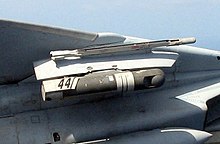LANTIRN
This article needs additional citations for verification. (June 2022) |
LANTIRN (Low Altitude Navigation and Targeting Infrared for Night) is a combined navigation and
Features
LANTIRN consists of a navigation pod and a targeting pod mounted externally beneath the aircraft.
The AN/AAQ-13 navigation pod provides high-speed penetration and precision attack on tactical targets at night and in adverse weather. The navigation pod contains a
AN/AAQ-14 targeting pod
The AN/AAQ-14 targeting pod contains a high-resolution,
Background
The research and development program began in September 1980 with
LANTIRN and the F-14 Tomcat

Until the early 1990s, the
The basic LANTIRN was modified into LANTIRN Targeting System (LTS), the navigation pod was removed from the two-pod system and the targeting pod was improved for Tomcat use. The LTS featured a Global Positioning System and inertial measurement unit that provided the pod line-of-sight cueing and weapon release ballistics and eliminated the need for external cumbersome and time-consuming boresight equipment.
Unlike the early versions, the LTS performed all weapon release calculations and presented release cues that it had generated to the aircrew. The LTS also had a masking avoidance curve display (preventing firing the laser at the jet) and eventually a north orientation curve and 12,200 m (40,000 ft) capable laser. The latter became very useful allowing F-14s to employ LGBs above potential threat systems and it came into its own in the higher terrain in Afghanistan during Operation Enduring Freedom.
The LTS could also generate coordinates for any target located on the FLIR, and a latter software modification, known as T3 (Tomcat Tactical Targeting) increased the accuracy of the coordinates produced by the LTS and allowed generated coordinates for GPS/INS guided weapons (
The pod also featured an internal computer with ballistics data for the various precision munitions carried by the F-14. Data is fed to the pod by the Tomcat's
The first combat use of the LTS was in December 1998 during
General characteristics
- Primary function: Low altitude navigation and targeting infrared for night flying
- Contractor: Lockheed Martin, Inc.
- Length: Navigation pod, 78.2 in (1.99 m); targeting pod, 98.5 in (2.51 m)
- Diameter: Navigation pod, 12 in (305 mm); targeting pod, 15 in (380 mm)
- Weight: Navigation pod, 451.1 lb (204.6 kg); targeting pod, 530 lb (240.7 kg)
- Aircraft: F-15E, F-16A/B Block 20 (MLU), F-16C/D Block 40, F-14 B/D, S-3B
- Sensors: Infrared and terrain following radar sensors on the navigation pod. Infrared and laser designator and ranging sensors on the targeting pod
- Introduction date: March 1987
- Unit cost: Navigation pod, $1.38 million; targeting pod, $3.6 million[2]
Operators
See also
- ATFLIR
- LITENINGAN/AAQ-28(V)
- Lockheed Martin Sniper XR
- Thales Damocles
- PDLCT
References
- user-generated source?]
- ^ "Official Site of the U.S. Air Force - Fact Sheet (Printable) : LANTIRN". Archived from the original on 2012-12-12.
- ^ Ellebaut, Stefaan. "Belgian Air Force buys eight Sniper XR targeting pods". F-16.net. Retrieved 28 June 2022.
- ^ "Egypt getting more LANTIRN targeting pods". defenceWeb. 2016-11-29. Retrieved 2020-10-06.
- ^ a b "AN/AAQ-13 & AN/AAQ-14 LANTIRN Navigation & Targeting Pod". F-16.net. Retrieved 28 June 2022.
- ^ "F-16 Air Forces - Israel". F-16.net. Retrieved 28 June 2022.
- ^ "143rd squadron (RSAF)". F-16.net. Retrieved 28 June 2022.
- ^ "155th Fighter Squadron (RoKAF)". F-16.net. Retrieved 28 June 2022.
- ^ "F-16 Air Forces - Republic of China / Taiwan". F-16.net. Retrieved 28 June 2022.
- ^ "F-16 Air Forces - Turkey". F-16.net. Retrieved 28 June 2022.
- ^ "USAF Fact Sheet - LANTIRN". af.mil. Retrieved 18 February 2023.
- ^ "New LANTIRN ER goes to war". navair.navy.mil. Retrieved 18 February 2023.
- Clancy, Tom (1996). Fighter Wing. London: HarperCollins, 1995. OCLC 33316967.
- Holmes, Tony (2014). US Navy F-14 Tomcat Units of Operation Iraqi Freedom. London: Osprey Pub. OCLC 869308208.
- Hildebrandt, Erik (2006). Anytime, Baby! Hail and Farewell to the US Navy F-14 Tomcat. Stillwater, MN: Cleared Hot Media. OCLC 225371634.
External links
- AN/AAQ-13 & AN/AAQ-14 [email protected]
- Targeting: in the hands of the pods International Defence Review, 7 September 2006


